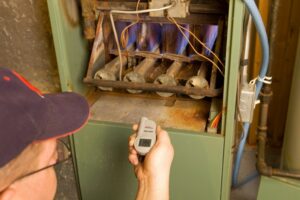 We never want to alarm our customers, but it’s an important part of our job as HVAC experts to let them know about potential harmful problems that can occur. The more you know about possible hazards with your gas furnace, the better you’ll be able to recognize when you need to call us for professional furnace repair in Conyers, GA.
We never want to alarm our customers, but it’s an important part of our job as HVAC experts to let them know about potential harmful problems that can occur. The more you know about possible hazards with your gas furnace, the better you’ll be able to recognize when you need to call us for professional furnace repair in Conyers, GA.
Before we go deeper into today’s topic—the cracked heat exchanger—we want to assure you that gas furnaces are designed to high safety specifications and under normal conditions aren’t dangerous for homes. With the proper steps, such as annual heating maintenance and prompt repair attention, you can enjoy warmth from your gas furnace in safety.
What Is a Heat Exchanger?
In simple terms, the heat exchanger is the part of a gas furnace that applies heat to the air that passes through the furnace and into the ventilation system. It’s a metal chamber that has a clamshell shape, and it takes up a large part of the center of a furnace.
When the burners in the furnace come on, the hot combustion gas they produce enters into the heat exchanger. The heat from the gas raises the temperature of the metal walls of the exchanger. Air from the blower fan passes around the exchanger and picks up the heat from its surface before it heads into the ductwork to the house. This prevents any of the combustion gas or its byproducts from coming in contact with the air that will enter the living spaces. When the heating cycle finishes, the heat exchanger vents out the cooled combustion gas vapor through a flue to the outside.
The Danger of Cracks on a Heat Exchanger
A small crack across the metal of a heat exchanger might not seem like a big problem. However, the metal of the heat exchanger expands as it heats up, and this can cause the crack to widen, potentially allowing toxic combustion gases to escape into the air heading into the house. This creates a danger of carbon monoxide poisoning among the household.
Cracks can happen because of long years of strain on the exchanger, or from corrosion that can develop because of exposure of gas vapor to the metal of the exchanger. This is one of the reasons we don’t recommend people keep a furnace longer than 15 years: the chance of a cracked heat exchanger rises when a heating system is this old.
Maintenance Is Your Best Tool Against a Cracked Heat Exchanger
Cracks in a heat exchanger don’t simply pop up suddenly, which makes it easy for technicians to catch warning signs early, such as corrosion or poor ventilation. But those technicians need the opportunity to inspect the furnace each year, and this is one of the reasons annual furnace maintenance is so vital.
When you schedule fall maintenance for your gas furnace with our team, we’ll make a special inspection of the venting and the heat exchanger to see if there may be cracks starting. We can help you stop this trouble before it starts and keep your family safe.
At Snellville Heating, Air and Plumbing, Your Comfort Is OUR Business. If you have furnace problems, call us for fast and effective service.




